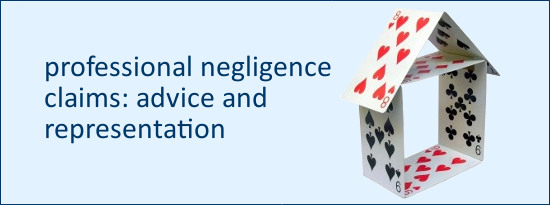We live in a society which is increasingly inclined to look for someone to blame when things go wrong
“Instant access to information, higher standards of living and a less fatalistic approach to life are just a few of the factors which have contributed to a fundamental shift in attitudes over the past 30 years. Times have changed… Ultimately, the task of the courts in determining the limits of professional liability is that of holding the ring between competing interests. Society needs professionals [but it also] needs them to be accountable to their clients.‘” (Mark Simpson)
Pre-action conduct in professional negligence cases
(Paragraph 9.3.1, professional negligence PAP.)
A party (and its legal representatives) must consider the potential impact of its behaviour at the pre-action stage of any dispute. This applies to all areas of litigation. There are specific pre-action protocols (PAPs) in place to be followed in particularly types of dispute and, if no specific protocol applies, the parties should follow the Practice Direction on Pre-action Conduct and Protocols. The court may impose sanctions on any party that fails to comply with the relevant pre-action procedure.
When does the professional negligence PAP apply?
The Professional Negligence Pre-Action Protocol:
- Does not apply to claims concerning:
- construction professionals, such as architects, engineers and quantity surveyors (instead, the Pre-Action Protocol for Construction and Engineering Disputes is likely to apply);
- healthcare professionals (when the Pre-action Protocol for the Resolution of Clinical Disputes should be used); or
- defamation (when the Pre-action Protocol for Defamation Claims should be used).
- May not be suitable for disputes relating to intellectual property claims. Procedural steps under the professional negligence PAP
Preliminary notice
The claimant should notify the professional in writing as soon as it decides there is a reasonable chance of a claim (preliminary notice) (paragraph 5, professional negligence PAP). The preliminary notice should:
- Identify the claimant and any other parties.
- Contain a brief outline of the claimant’s grievance.
- Provide a general indication of its financial value, if possible.
- Ask the professional to inform his professional indemnity insurers immediately.
This may be the stage at which solicitors are first instructed, so they may have little information about the nature of the claim.
The professional should acknowledge receipt of the letter within 21 days of receiving it (paragraph 5.4, professional negligence PAP). Note that, if after six months from receipt of the preliminary notice, the claimant has not sent any further correspondence regarding the claim, the claimant should notify the professional if its intentions with regard to the claim.

Letter of claim
As soon as the claimant decides there are grounds for a claim, it should send a letter of claim to the professional (paragraph 6.1, professional negligence PAP). The letter of claim should comply with the requirements of paragraph 6.2 and, in particular, enclose copies of key documents.
On receipt of the letter of claim, the professional must:
- Acknowledge receipt within 21 days (paragraph 7.1). If the claimant is unrepresented, a copy of the professional negligence PAP should be provided with the letter of acknowledgment (paragraph 7.2).
- Within 3 months from the date of the letter of acknowledgment, investigate the claim and respond to the claimant by providing either a letter of response or a letter of settlement, or both (paragraph 8.2.). If there are reasonable grounds, it may be possible to obtain an extension of time.
Consider whether the letter of claim complies with the professional negligence PAP. If it does not comply with the requirements of paragraph 6, the professional must, as soon as reasonably practicable inform the claimant why, and identify the further information required.
A defendant needs to consider whether the letter of claim sets out a cogent case against the professional or simply alleges that something has gone wrong and attempts to blame the professional. If the claim is a response to a request for fees to be paid, this can indicate a poor case being put forward to justify non-payment.
What evidence has been provided for the allegations? For example:
- Has expert evidence been obtained and disclosed?
- Have key documents referred to in the letter of claim been provided?
- Has the claimant provided copies of letters sent to other professionals?
It is advisable for a defendant to carry out a proper investigation of the claim before responding to the letter of claim. It can be helpful to proof witnesses and obtain evidence at this stage, if you have not already done so. If necessary, seek an extension of time to respond to the letter of claim.
Paragraph 12.1 specifies that parties should consider whether some form of alternative dispute resolution procedure is more suitable than litigation. The parties may be required to provide evidence to the court that alternative means of resolving the dispute were considered.
Case law suggests that ignoring a request to engage in ADR may result in an adverse costs award when the dispute is eventually resolved.
Response to the Letter of Claim
As soon as the professional has completed the investigation (and in any event, within 3months of the letter of acknowledgment, unless an extension of time has been agreed), they should send to the claimant:
- A Letter of Response.
- A Letter of Settlement.
- Both.
(Paragraph 9.1, professional negligence PAP.)
If the Letter of Response denies the claim in its entirety and there is no Letter of Settlement, it is open to the claimant to commence court proceedings. In any other circumstance, the professional and the claimant should commence negotiations with the aim of resolving the claim within 6 months of the date of the Letter of Acknowledgment (paragraph 9.4.2).
If the claim cannot be resolved within the 6-month period, the parties should, within 14 days, agree whether the period should be extended (and, if so, by how long) for the parties to seek to identify the issues in dispute and those that can be agreed. If no extension of time is agreed, it is open to the claimant to commence court proceedings (paragraph 9.4.3).
The PAP also contains a “stocktake” provision. This provides that, if the protocol procedure has not resolved the dispute, the parties should undertake a further review of their respective positions. The parties should consider the state of the papers and the evidence to see if proceedings can be avoided and the issues narrowed (paragraph 13.1).
Letter of Response
This is an open letter responding to the claimant’s allegations. Although it does not have the formal status of a defence, the court may impose sanctions if it differs materially from the defence in any subsequent court proceedings (paragraph 9.2.2).
A letter of response should comply with the provisions of paragraph 9.2.1 of the professional negligence PAP. In particular, it should:
- Make it clear which parts of the claim are admitted and denied.
- Comment specifically on the allegations.
- If the claimant’s estimated loss is disputed, set out the professional’s estimate, or explain why an estimate cannot be provided and when you will be in a position to provide an estimate.
- Identify and enclose copies of key documents, if not already exchanged.
Letter of Settlement
A Letter of Settlement may be in the form of either:
- An open letter.
- A without prejudice letter.
- A without prejudice save as to costs letter.
- An offer pursuant to CPR (Court Rules) Part 36.





